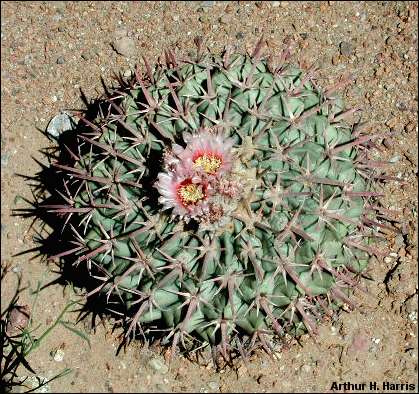

When plants and animals breath, they take in oxygen and give off water and carbon dioxide as waste. But plants need lots of additional carbon dioxide and water to manufacture food with the aid of sunlight. Luckily for animals, the waste product of this photosynthesis is oxygen. Carbon dioxide and oxygen are gases that enter and leave the plant through closable pores in the leaves and stems called stomata. In the desert, though, this is a problem, because opening the stomata to let in carbon dioxide results in water loss—transpiration.
Many desert succulents meet the challenge by utilizing a photosynthetic
route known as CAM (for Crassulacean Acid Metabolism, if you have to know). CAM works
by letting carbon dioxide into the plant at night, when water loss is lessened because
the temperature is lower and the humidity higher. The carbon dioxide is stored as part
of an acid. During the day, the stomata are closed, protecting precious water stores,
but the plant performs photosynthesis using the stored carbon dioxide to make
carbohydrates. Problem solved.

Listen to the Audio (mp3 format) as recorded by KTEP, Public Radio for the Southwest.
Contributor: Arthur H. Harris, Laboratory for Environmental Biology, University of Texas at El Paso.
Desert Diary is a joint production of the Centennial Museum and KTEP National Public Radio at the University of Texas at El Paso.

The cacti are one group of plants utilizing the CAM pathway. Chihuahuan Desert Gardens. Photograph by A. H. Harris.
Dimmit, M. A. 2000. Pp. 129-151, in S. J. Phillips and P. W. Comus, eds. A Natural History of the Sonoran Desert. Arizona-Sonora Desert Museum Press, Tucson, 628 pp.
Comparison of C3, C4, and CAM photosynthesis.